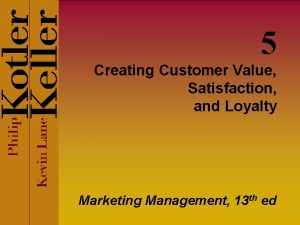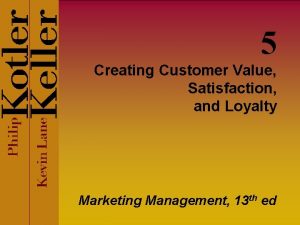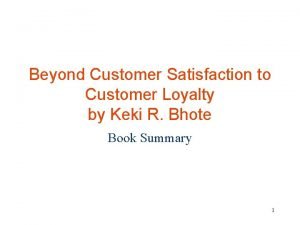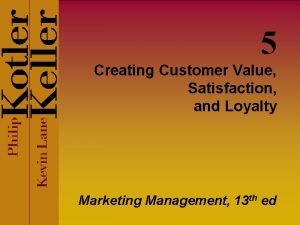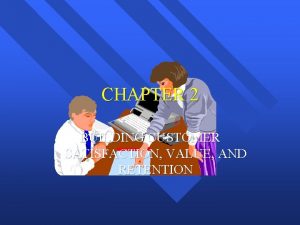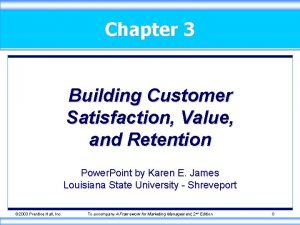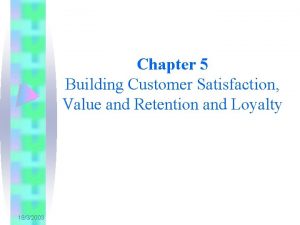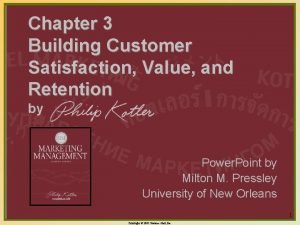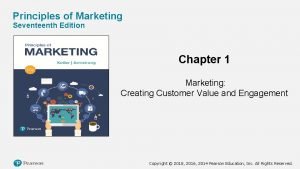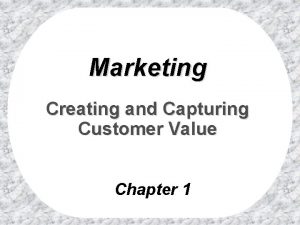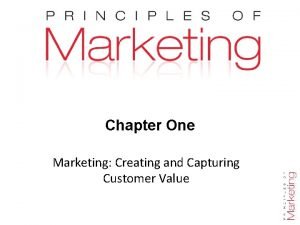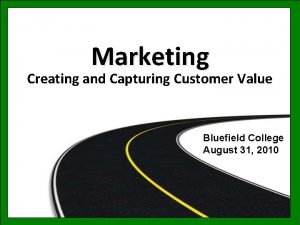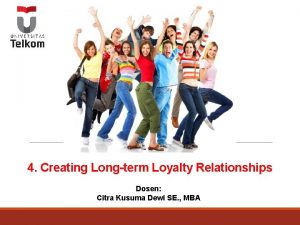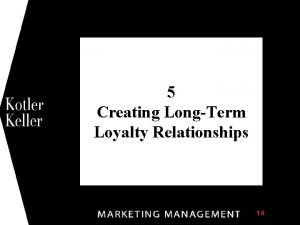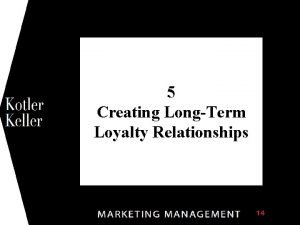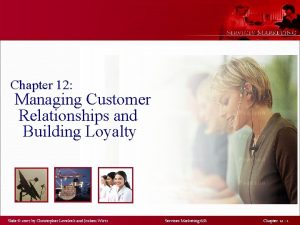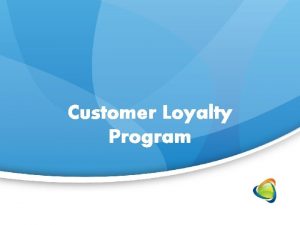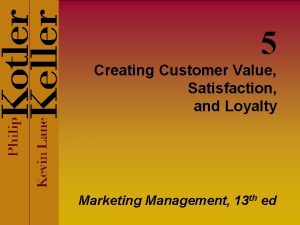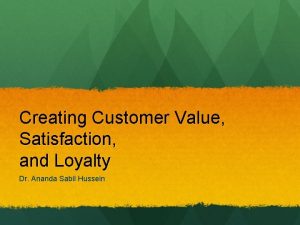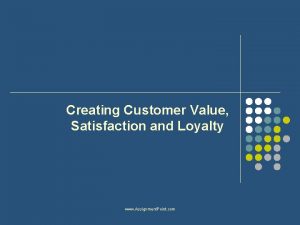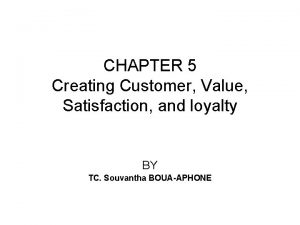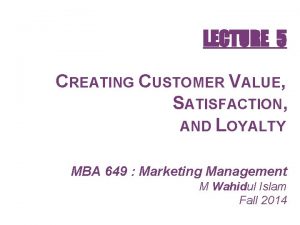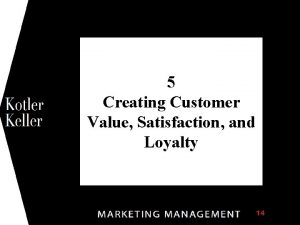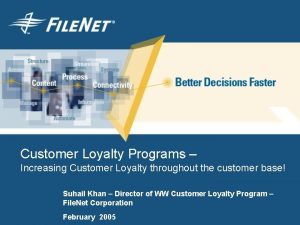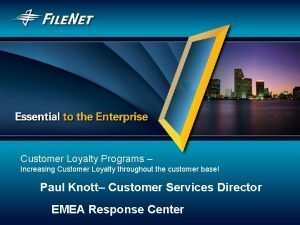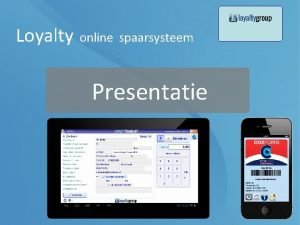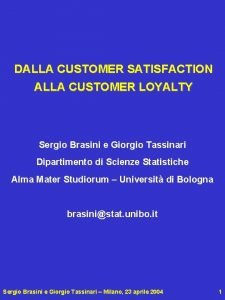04 Creating Customer Value Satisfaction and Loyalty An




















- Slides: 20

04 Creating Customer Value, Satisfaction, and Loyalty: An Strategic Marketing Goal

Organizational Charts Copyright © 2009 Pearson Education, Inc. Publishing as Prentice Hall 5 -2

Customer Experience Management (CEM) • Managing the customers’ interactions with the organization at all levels and at all touch-points so that the customer has a positive impression of the organization, is satisfied with the experience, and will remain loyal to the organization. Copyright © 2009 Pearson Education, Inc. Publishing as Prentice Hall 5 -3

Determinants of Customer Perceived Value Total customer benefit Total customer cost Product benefit Monetary cost Services benefit Time cost Personal benefit Energy cost Image benefit Psychological cost Copyright © 2009 Pearson Education, Inc. Publishing as Prentice Hall 5 -4

What is Loyalty? Loyalty is a deeply held commitment to re-buy or re-patronize a preferred product or service in the future despite situational influences and marketing efforts having the potential to cause switching behavior. Copyright © 2009 Pearson Education, Inc. Publishing as Prentice Hall 5 -5

The Value Proposition The whole cluster of benefits the company promises to deliver Copyright © 2009 Pearson Education, Inc. Publishing as Prentice Hall 5 -6

Measuring Satisfaction Periodic Surveys Customer Loss Rate Mystery Shoppers Monitor Competitive Performance Copyright © 2009 Pearson Education, Inc. Publishing as Prentice Hall 5 -7

What is Satisfaction • It is a person’s feeling of pleasure or disappointment resulting from comparing a product’s perceived performance (or outcome) in relation to his or her expectations. • Satisfaction = function (perceived performance /expectations) Copyright © 2009 Pearson Education, Inc. Publishing as Prentice Hall 5 -8

Benefits of Highly Satisfied Customer • • Stays Loyal Longer Buys more Talks favorably about the company Offer products and services ideas to the company • Costs less to serve than new customer Copyright © 2009 Pearson Education, Inc. Publishing as Prentice Hall 5 -9

What is Quality? Quality is the totality of features and characteristics of a product or service that bear on its ability to satisfy stated or implied needs. Copyright © 2009 Pearson Education, Inc. Publishing as Prentice Hall 5 -10

Maximizing Customer Lifetime Value Customer Profitability Customer Equity Lifetime Value Copyright © 2009 Pearson Education, Inc. Publishing as Prentice Hall 5 -11

Customer Relationship Management (CRM) • Customer relationship management is the process of identifying prospective buyers, understanding them intimately, and developing long-term perceptions of the organization and its offering so that buyers will choose them in the marketplace. Copyright © 2009 Pearson Education, Inc. Publishing as Prentice Hall 5 -12

What is Customer Relationship Management? CRM is the process of carefully managing detailed information about individual customers and all customer touchpoints to maximize customer loyalty. Copyright © 2009 Pearson Education, Inc. Publishing as Prentice Hall 5 -13

Framework for CRM Identify prospects and customers Differentiate customers by needs and value to company Interact to improve knowledge Customize for each customer Copyright © 2009 Pearson Education, Inc. Publishing as Prentice Hall 5 -14

CRM Strategies Reduce the rate of defection Increase longevity Enhance “share of wallet” Terminate low-profit customers Focus more effort on high -profit customers Copyright © 2009 Pearson Education, Inc. Publishing as Prentice Hall 5 -15

Customer Retention • Acquisition of customers can cost five times more than retaining current customers. • The average customer loses 10% of its customers each year. • A 5% reduction to the customer defection rate can increase profits by 25% to 85%. • The customer profit rate increases over the life of a retained customer. Copyright © 2009 Pearson Education, Inc. Publishing as Prentice Hall 5 -16

The Customer Development Process Suspects Prospects First-time customers Disqualified Repeat customers Clients Ex-customers Copyright © 2009 Pearson Education, Inc. Publishing as Prentice Hall Members Partners 5 -17

Database Key Concepts • Customer database • Database marketing • Mailing list • Business database • Data warehouse • Data mining Copyright © 2009 Pearson Education, Inc. Publishing as Prentice Hall 5 -18

Using the Database To identify prospects To target offers To deepen loyalty To reactivate customers To avoid mistakes Copyright © 2009 Pearson Education, Inc. Publishing as Prentice Hall 5 -19

• Basic Marketing: selling the product • Reactive Marketing: selling the product and encouraging further contact • Accountable Marketing: Follow up on Customers satisfaction. • Proactive marketing: involving customers in product and company improvements • Partnership marketing: encouraging the customer to become a stakeholder in the company Copyright © 2009 Pearson Education, Inc. Publishing as Prentice Hall 5 -20
 What are customer value satisfaction and loyalty
What are customer value satisfaction and loyalty What are customer value satisfaction and loyalty
What are customer value satisfaction and loyalty Creating customer value satisfaction and loyalty
Creating customer value satisfaction and loyalty Beyond customer satisfaction to customer loyalty
Beyond customer satisfaction to customer loyalty What is customer value satisfaction and loyalty
What is customer value satisfaction and loyalty Undivided loyalty
Undivided loyalty Building customer satisfaction
Building customer satisfaction How to build customer satisfaction value and retention
How to build customer satisfaction value and retention Building customer satisfaction value and retention
Building customer satisfaction value and retention Customer satisfaction value and retention
Customer satisfaction value and retention Marketing chapter 1
Marketing chapter 1 Creating and capturing customer value
Creating and capturing customer value Creating and capturing customer value
Creating and capturing customer value 5 core customer and marketplace concepts
5 core customer and marketplace concepts Creating value and capturing value
Creating value and capturing value Creating long term loyalty relationship
Creating long term loyalty relationship Questions about loyalty in relationships
Questions about loyalty in relationships Creating long term loyalty relationships
Creating long term loyalty relationships 6m's
6m's Managing customer relationships and building loyalty
Managing customer relationships and building loyalty Top-2-box customer satisfaction
Top-2-box customer satisfaction
